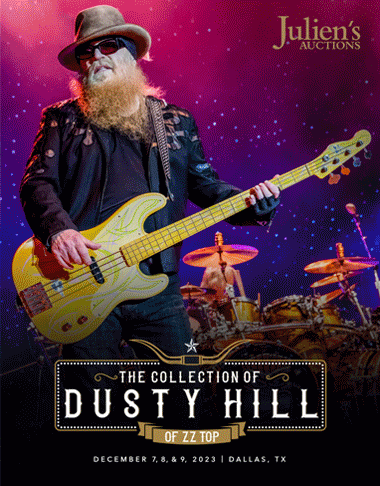Property From The Life and Career of Richard Chamberlain Limited Edition Catalogue
JULIEN’S AUCTIONS PROUDLY PRESENTS “PROPERTY FROM THE LIFE AND CAREER OF RICHARD CHAMBERLAIN” AN EXCLUSIVE AUCTION TAKING PLACE LIVE IN BEVERLY HILLS AND STREAMING ONLINE AT JULIEN’S LIVE ON SATURDAY, DECEMBER 17TH.
View Auction Results
Property From The Personal Collection Of Richard Chamberlain is an exclusive presentation honoring the legendary multi-Golden Globe Award-winning and Emmy-nominated actor’s extraordinary six decade spanning career, taking place live in Beverly Hills and on Julien’s Live on December 17th.
On offer is an exclusive collection featuring the icon’s awards, wardrobe, and memorabilia from his classic films, television series, and plays, a collection of his artworks, as well as furnishings, art, watches, jewelry, and other items from his personal collection.

Click to Order Limited Edition Catalogue
Actor, writer, artist, producer, environmental activist, and spiritual seeker Richard Chamberlain was born in Los Angeles on March 31, 1934. He was close with his mother, Elsa Winnifred, an actress, stage director, pianist and singer, and his grandmother, who had a brief career as an actress on Broadway and professional singer. Chamberlain wanted to follow in their footsteps and act, but shyness and insecurity made him fear he wouldn’t be successful. Instead, he entered Pomona College as a painting and art history major, intending to become a commercial artist. However, when he attended auditions for a college production of
George Washington Slept Here, just to watch, the play’s director asked him to try out for the part of a flamboyant actor. Thus began his college career as a performer, where he fell in love with acting in productions including
The Crucible and
Arms and the Man. In his senior year, he was approached by a talent scout at Paramount Pictures, where he was offered a seven-year contract. However, his career was interrupted when he was drafted into the U.S. Army. After serving in Korea for two years, he was honorably discharged.
Returning to California in the late 1950s, Chamberlain reconnected with his college friend, future
Chinatown screenwriter Robert Towne. They took acting classes with Jeff Corey, a respected method actor who became a noted teacher after being blacklisted in the 1950s by the House of Un-American Activities Committee. In order to hone their craft during professionally fallow periods, he and his classmates began The Angel’s Company in Los Angeles and put on acclaimed plays including
La Ronde and
The Caine Mutiny Court-Martial. Shortly after, Chamberlain began to have success as a professional actor, with appearances on
Gunsmoke, Alfred Hitchcock Presents, Thriller, and other television series, as well as a small role in the film
The Secret of Purple Reef.
Chamberlain’s turn as a Yale graduate-turned-cowboy in the unsuccessful pilot
The Paradise Kid landed him a contract with MGM, who were on a lengthy search for the protagonist of a new modernized series about Dr. Kildare, the popular 1930s fictional medical intern. Chamberlain was cast opposite Raymond Massey, and almost immediately became a household name and pop culture sensation. The series was watched by 8 million viewers in thirty-one countries, and Chamberlain broke studio records by receiving 12,000 fan letters a week. In between seasons of
Dr. Kildare, Chamberlain acted in the MGM films
A Thunder of Drums (1961),
Twilight of Honor (1963), and
Joy in the Morning (1965). At this time, he also proved himself as a singer, scoring hits with “Theme from Dr. Kildare (Three Stars Will Shine Tonight)” and covers of “All I Have to Do is Dream” and “Love Me Tender.”
In 1963 Chamberlain won his first Golden Globe for Best Performance by an Actor in a Television Series for
Dr. Kildare. Between 1961 and 1966, he also won the Photoplay Gold Medal for Best Actor in Movies and Television three times, the
TV Guide award for Most Popular Male Star, and the Hollywood Women’s Press Club Golden Apple award for Most Cooperative Male Star.
After
Kildare ended in 1966, Chamberlain surprised many by turning down other lucrative TV series offers to get acting training he felt he was lacking, and earn respect as a serious thespian, in theater. He first worked in summer stock, in productions including
The Philadelphia Story at the Royal Poinciana Playhouse in Palm Beach, Florida and
Private Lives with the John Kenley Players in Ohio. His theater work led to a star turn on Broadway in a 1966 musical version of Truman Capote’s
Breakfast at Tiffany’s written by Edward Albee and co-starring Mary Tyler Moore. The production, a notorious critical and box office failure, closed after four previews in New York.
Chamberlain decided to pursue work in England, where he identified with the country’s culture and its preferred acting techniques. He received attention for his first villain role as an abusive husband finally beaten up by his wife, played by Julie Christie, in the hip British-American film
Petulia (1968) directed by Richard Lester (
A Hard Day’s Night).
Further opportunities on the English stage and screen followed, beginning with a multi-episode BBC TV production of
The Portrait of a Lady (1968). This role, which Chamberlain has described as one of his most important learning experiences, led to a watershed moment in Chamberlain’s career, an opportunity to star in Birmingham Repertory Theatre’s 1969 production of
Hamlet. Although several acting teachers advised him to turn down the role, he took on the challenge, and was met with critical acclaim and a sold-out run.
Hamlet lay the groundwork for Chamberlain’s burgeoning reputation as an important classical actor, working frequently in acclaimed period theater, television, and film productions throughout the 1970s, including a televised play production of
Hamlet co-starring Sir John Gielgud, Sir Michael Redgrave, and Margaret Leighton; several productions of
Richard II; the film
Lady Caroline Lamb, in which he played Lord Byron; and the made for TV movie
The Man in the Iron Mask. He received a Los Angeles Theatre Critic’s Award for his performance in Edmond Rostand’s 1973 production of
Cyrano de Bergerac, and also starred in a television production of
The Lady’s Not for Burning, a play which inspired him at Pomona College. He received his first Emmy nomination in 1975 for a television production of
The Count of Monte Cristo.
He collaborated with cinematic royalty on several prestigious, sometimes unconventional feature films. In 1969 he co-starred with Katharine Hepburn in the comedy
The Madwoman of Chaillot, directed by Bryan Forbes (with whom he’d work again on the Cinderella story
The Slipper and the Rose); and played Octavius Caesar in a notorious film of
Julius Caesar co-starring Charlton Heston and Jason Robards. He worked with several of the period’s major filmmakers, playing Tchaikovsky opposite Glenda Jackson in eccentric filmmaker Ken Russell’s controversial 1971 film
The Music Lovers; and reuniting with Richard Lester to star as the suave Aramis in the witty, beloved cult classics
The Three Musketeers and
The Four Musketeers with Michael York, Oliver Reed, Faye Dunaway, Raquel Welch, Charlton Heston, and Christopher Lee in 1973 and 1974.
Eager to also play contemporary roles, Chamberlain braved disaster by joining the all-star casts of Irwin Allen’s spectacles
The Towering Inferno and
The Swarm. He also collaborated with celebrated filmmaker Peter Weir in the 1977 Australian film
The Last Wave, receiving rave reviews for playing a contemporary lawyer who begins to have frightening dreams, visions, and self-revelations while defending five Aboriginal Persons in a ritualized murder case. He won the Clavell de Plata Best Actor Award at the Catalonian International Film Festival and was nominated for Best Actor in a Lead Role by the Australian Film Institute.
Late in the decade, Chamberlain continued his strong theater career. 1977 brought Chamberlain’s much more successful return to Broadway in Circle in the Square’s production of Tennessee Williams’s
Night of the Iguana, for which he was nominated for a Drama Desk Award. Off-Broadway, he had one of his favorite roles in the 1978 production of Thomas Babe’s play
Fathers & Sons at The Public Theatre, opposite Dixie Carter, in what
The New York Times called “a transforming performance.”
In 1978, Chamberlain starred in
Centennial, a prestigious example of the relatively new format known as the television miniseries, which chronicled the economic and cultural growth of Colorado from the mid-1700s to the late 1970s. He received a Golden Globe nomination for his work. His enthusiasm for the format, which allowed for more character and story development than a feature film, made him fight for the lead role in a miniseries adaptation of James Clavell’s bestselling novel
Shogun. He ultimately won the role of John Blackthorne, a British sailor who washes ashore in Japan in 1600 and finds himself in the middle of civil war and social upheaval. Production of the lush historical epic proved both enriching and torturous, marked by tensions between its Japanese and American crews. Its airing in 1980 was a tremendous success. Chamberlain won a Golden Globe Award for Best Performance by an Actor in a Television Series - Drama and a Best Actor Award from London’s
TV Times magazine, and was nominated for a Primetime Emmy Award for Outstanding Lead Actor in a Miniseries, or Special.
Chamberlain felt an equally passionate desire to play the starring role in
The Thorn Birds (1983). The epic, tragic romance was another smash success and cultural phenomenon, garnering him a Golden Globe Award and Emmy nomination. The tortured priest Father Ralph de Bricassart became one of his most iconic roles. Because of Chamberlain’s success in this format, he became known as “The King of the Miniseries,” and would star in many more throughout next two decades, including
Dream West, Casanova, The Bourne Identity, The Thorn Birds: The Missing Years, Too Rich: The Secret Life of Doris Duke, and
Wallenberg: A Hero’s Story, for which he received Emmy and Golden Globe nominations.
In 1985, Chamberlain spent a year in Zimbabwe filming the cult classic action-adventure feature films
King Solomon’s Mines and
Allan Quatermain and the Lost City of Gold. In 1987 he returned to Broadway opposite Geraldine Page in
Blithe Spirit by Noel Coward, one of his favorite playwrights. At the end of the decade, he returned to series television, and the medical field, with the series
Island Son, co-created by his partner and future husband, Martin Rabbett. The series was filmed in Hawaii, where Chamberlain and Rabbett shared a beloved home. Chamberlain executive produced two episodes.
In the early 1990s, Chamberlain returned to painting for the first time since he graduated from college. Several years later, he had a one-man show at The Celebrity Gallery on the island of Maui, one of the biggest art markets in the world. As the decade progressed, he found new challenges, and success, in musical theater in Broadway and touring productions of
My Fair Lady and
The Sound of Music. He also starred in various made for TV movies, including
Night of the Hunter and
All the Winters That Have Been, and in the independent film
River Made to Drown In. In 2000, he was honored with a star on the Hollywood Walk of Fame.
In 2003, Chamberlain published
Shattered Love: A Memoir, which combined stories of his life and career with lessons he’d learned from many spiritual teachers including, prominently, J. Krishnamurti. Famously private, he publicly chronicled for the first time his sometimes rocky personal journey, including his tumultuous relationship with his father and coming to terms with being a gay man in the notoriously closeted entertainment industry. The book was met with much support from critics and fans. Chamberlain’s new openness likely led to roles as openly gay men in the Adam Sandler film
I Now Pronounce You Chuck and Larry and on the series
Nip/Tuck, Desperate Housewives, and
Brothers & Sisters.
A new generation was introduced to Chamberlain through these frequent guest star appearances on popular television series, which also included
Touched by an Angel,
The Drew Carey Show (on which he appeared in drag),
Will & Grace, Chuck, and the 2017 revival of
Twin Peaks. During this period, he starred in independent feature films like
The Perfect Family and
We are the Hartmans. In 2009, Chamberlain showed off his surprising knack for creating lunatic hilarity as King Arthur in the National Touring Production of
Monty Python’s Spamalot. Several years later, he entered the DC comics universe as the voice of Highfather in the animated original movie
Justice League: Gods and Monsters.
Throughout his career, Chamberlain has been a passionate environmental activist, lobbying in Sacramento, California and Washington D.C. to save the Tuolumne River flowing from Yosemite National Park in California, which helped to win a “Wild and Scenic” designation for the river. He has worked repeatedly with The National Audubon Society on documentaries including 1989’s
Wildlife: Poaching in America, a television special about the poaching of animals in National forests, and 1993’s
Hawaii: Paradise in Peril, on a special about Hawaii’s struggle to balance its reliance on tourism with environmental concerns. In 1989 he was the principal speaker at the San Francisco Ecological Convention.
Highlights include:
“DR. KILDARE” 1963 GOLDEN GLOBE AWARD
Chamberlain’s first of three Golden Globe awards, presented to him by the Hollywood Foreign Press Association in 1963 for Best Performance by an Actor in a Television Series on
Dr. Kildare (NBC, 1961-66), the series that made him a star and a pop culture phenomenon.
“SHOGUN” 1981 GOLDEN GLOBE AWARD
A Golden Globe award presented to Richard Chamberlain by the Hollywood Foreign Press Association in 1981 for Best Performance by an Actor in a Television Series Drama for his performance in the classic miniseries
Shogun (NBC, 1980). Richard Chamberlain was passionate about starring in a miniseries adaptation of James Clavell's bestselling book. Although actors such as Robert Redford (for a theatrical feature), Sean Connery, and Albert Finney were originally approached, Chamberlain's patience and passion paid off and he got the part of John Blackthorne, an English explorer who is shipwrecked in feudal Japan and finds himself at the center of civil war and social upheaval. The program was a blockbuster, cementing Chamberlain’s reputation as The King of the Miniseries.
“SHOGUN” ORIGINAL COSTUME AND “SHOGUN” TV GUIDE COVER PORTRAIT
An original costume from the production of the classic miniseries
Shogun (NBC, 1980). The costume includes a beige linen kimono with brown patterning, brown and white
kataginu kamishimo, pale blue obi, and gray-brown slippers. Chamberlain wears this costume in Richard Amsel’s portrait which appeared on the cover of the September 6, 1981 issue of
TV Guide advertising the miniseries. A print of the portrait, given to Chamberlain as a memento by
TV Guide in 1980, will also be sold at auction.
“THE THORN BIRDS” 1984 GOLDEN GLOBE AWARD
A Golden Globe award presented to Richard Chamberlain by the Hollywood Foreign Press Association in 1984 for Best Performance by an Actor in a Television Series Drama for his performance in the classic miniseries
The Thorn Birds (David Wolper-Stan Margulies Productions, 1983). Accepting the award, Chamberlain said “I’m very grateful to the Hollywood Foreign Press Association for their enduring kindness to me over the years.”
In Shattered Love: A Memoir (Regan Books, 2004), Chamberlain writes: "When I read…Colleen McCullough's epic novel about the travails of an Australian family, I immediately knew this passionate love story cried out to be a great television miniseries. I also knew I had to play Father Ralph, a character whose stature and complexity seemed to be an irresistible challenge." Father Ralphde Bricassart is one of the roles for which he remains most well-known.
“THE THORN BIRDS” X-RAYS
A set of X-rays of Chamberlain’s hand, which he broke while shooting the miniseries
The Thorn Birds (David Wolper-Stan Margulies Productions, 1983). Chamberlain says: “In a scene with Jean Simmons, I couldn’t remember my lines and got so frustrated I hit my hand on a camera dolly and broke it.”
HOLLYWOOD WALK OF FAME PLAQUE
A plaque presented to Richard Chamberlain on February 29, 2000 by the Hollywood Chamber of Commerce to commemorate the placement of his star on the Hollywood Walk of Fame. Chamberlain was starring as Captain Von Trapp in
The Sound of Music at the Pantages Theatre in Los Angeles at the time.
SIGNED ART PRINTS BY CHAMBERLAIN
(“Celestial Ardor” print)
(“An Angel of Sorts” print)
(“Conception Imminent” print)
(“Birth of a Rainbow” print)
(“Age and Wisdom” print)
Several signed prints of artworks composed by Chamberlain, including “Celestial Ardor,” “An Angel of Sorts,” “Conception Imminent,” “Birth of a Rainbow,” and “Age and Wisdom.”
In Shattered Love: A Memoir, Chamberlain writes: “Painting is related to acting in that shape, line, color, and rhythm are intrinsic to both, but the creative process is almost totally different. Acting is done by committee—it’s a cocreation with sometimes dozens of other people…Painting on the other hand is done alone; you’re the boss and the only responsible party. You fill the empty canvas with no one but yourself.”
“THE MADWOMAN OF CHAILLOT” KATHARINE HEPBURN GIFTED SUEDE GLOVES
A pair of suede gloves gifted to Chamberlain by Katharine Hepburn when they worked together on the comedic film
The Madwoman of Chaillot (Commonwealth United Entertainment, 1969) in Nice. In
Shattered Love: A Memoir, Chamberlain writes he was startled when Federico Fellini visited the set and Hepburn told him that his recent films demonstrated that “like that crazy Picasso, you’ve gone berserk.”
“THE MUSIC LOVERS” ORIGINAL SIGNED AND ANNOTATED SCREENPLAY
Richard Chamberlain’s original screenplay from the production of Ken Russell’s film
The Music Lovers (Russ-Arts, 1971), in which he played Pyotr Illyich Tchaikovsky, bearing the film’s early title
The Lonely Heart. The screenplay is signed by Chamberlain and annotated in his hand, and contains white and pink pages, demarcating different revisions. Russell and Chamberlain inspired controversy with the film, which posits that the composer’s inspiration, and madness, were rooted in his repressed homosexuality. In
Shattered Love: A Memoir, Chamberlain describes the film as “bizarre” and his co-star Glenda Jackson as “astonishing.”
“WALLENBERG: A HERO’S STORY” 1985 EMMY AWARD NOMINATION CERTIFICATE
A certificate presented to Richard Chamberlain by The Academy of Television Arts and Sciences for being nominated for an Emmy Award in the category “Outstanding Lead Actor in a Limited Series” for
Wallenberg: A Hero’s Story in 1985.
“ALLAN QUATERMAIN” ORIGINAL COSTUME AND HAT
A felt hat with a genuine cheetah fur band worn by Richard Chamberlain as “Allan Quatermain” in the cult classic film
King Solomon’s Mines (The Cannon Group, 1985) and its sequel
Allan Quatermain and the Lost City of Gold (Cannon Films, 1986); and a costume he wore in the sequel, consisting of a pair of green-brown suede pants and matching shirt. Chamberlain became an ‘80s-style action-adventure hero in the cult classic films based on the character from H. Rider Haggard’s novel. He shared the screen with Sharon Stone in both films, along with future-husband Martin Rabbett and friend Cassandra “Elvira Mistress of the Dark” Peterson in the sequel. They were shot back-to-back in Zimbabwe.
“MONTY PYTHON’S SPAMALOT” ANNOTATED SCRIPT
A script for the national touring production of the hit musical comedy
Monty Python’s Spamalot, in which Chamberlain starred as King Arthur. The script has frequent annotations in Chamberlain’s hand, presenting a portrait of how he developed the role in what he has described as his “favorite job ever.”
BVLGARI AT GL 18K WRISTWATCH
An Anfiteatro Bulgari 18k gold wristwatch of quartz movement, the cream-colored circular dial with gold baton and Roman numerals, window for date, within a BVLGARI engraved bezel and 18k gold case, joined to a brown leather strap, with an 18k gold buckle, 34 mm case, case back signed Bulgari, no. AT35, with a Bulgari blue leather fitted case.
LES MUST DE CARTIER WRISTWATCH
A Les Must de Cartier wristwatch by Cartier, of mechanical movement, the brown rectangular dial with gold hands, within a gold plated sterling silver case, with sapphire cabochon crown, joined to the brown leather strap, case back signed Cartier, nos. 6 1980 10.
BAUME & MERCIER TIFFANY & CO. WRISTWATCH
A stainless steel and gold tone wristwatch by Baume & Mercier retailed by Tiffany & Co., of quartz movement, the circular white dial with black Arabic numerals silvered hands, window for date, within a gold tone bezel and stainless steel case, joined to a gold tone and stainless steel link bracelet with deployant clasp, 7 inches, 35 mm case, caseback 5312.14, MVO45215, within a Baume & Mercier presentation case.
18K GOLD DIAMOND PENDANT NECKLACE
An 18k gold necklace, the fine link chain suspending a circular-cut diamond pendant, gauged to weigh approximately 0.40 carats, 2.00 grams total weight.
View Auction Results
This limited catalogue also provides an opportunity for a special keepsake for your collection.
Customers who purchased this item also bought...

Beats & Threads: Fashion of a Beatle (Signed Clamshell Edition & Video)
|

Beats & Threads: Fashion of a Beatle (Signed Slipcase Edition)
|

Beats & Threads: Fashion of a Beatle
|

The Collection of Dusty Hill of ZZ Top Limited Catalogue Slipcase Set
|